Potřebujeme váš souhlas k využití jednotlivých dat, aby se vám mimo jiné mohly ukazovat informace týkající se vašich zájmů. Souhlas udělíte kliknutím na tlačítko „OK“.
ASTM G205-10
Standard Guide for Determining Corrosivity of Crude Oils
Automaticky přeložený název:
Standardní Průvodce pro stanovení korozní agresivity surových olejů
NORMA vydána dne 1.9.2010
Informace o normě:
Označení normy: ASTM G205-10
Poznámka: NEPLATNÁ
Datum vydání normy: 1.9.2010
Kód zboží: NS-57600
Počet stran: 10
Přibližná hmotnost: 30 g (0.07 liber)
Země: Americká technická norma
Kategorie: Technické normy ASTM
Kategorie - podobné normy:
Anotace textu normy ASTM G205-10 :
Keywords:
corrosivity, crude oil, emulsion, mixed wet, oil-in-water emulsion, oil wet, water-in-oil emulsion, water wet, wettability, ICS Number Code 75.040 (Crude petroleum)
Doplňující informace
| Significance and Use | ||||||||||||||||||||||||||||||||||||||||||
|
In the absence of water, the crude oil is noncorrosive. The presence of sediment and water makes crude oil corrosive. Test Methods , , , and provide methods for the determination of the water and sediment content of crude oil. The corrosivity of crude oil containing water can be determined by a combination of three properties (Fig. 1) (1) : the type of emulsion formed between oil and water, the wettability of the steel surface, and the corrosivity of water phase in the presence of oil. Water and oil are immiscible but, under certain conditions, they can form emulsion. There are two kinds of emulsion: O/W and W/O. W/O emulsion (in which oil is the continuous phase) has low conductivity and is thus less corrosive; whereas O/W (in which water is the continuous phase) has high conductivity and, hence, is corrosive (see ISO 6614) (2). The conductivities of various liquids are provided in Table 1(3). The percentage of water at which W/O converts to O/W is known as the emulsion inversion point (EIP). EIP can be determined by measuring the conductivity of the emulsion. At and above the EIP, a continuous phase of water or free water is present. Therefore, there is a potential for corrosion. Whether water phase can cause corrosion in the presence of oil depends on whether the surface is oil wet (hydrophobic) or water wet (hydrophilic) (4-8). Because of higher resistance, an oil-wet surface is not susceptible to corrosion, but a water-wet surface is. Wettability can be characterized by measuring the contact angle or the conductivity (spreading method). In the contact angle method, the tendency of water to displace hydrocarbon from steel is measured directly by observing the behavior of the three phase system. The contact angle is determined by the surface tensions (surface free energies) of the three phases. A hydrocarbon-steel interface will be replaced by a water-steel interface if this action will result in an energy decrease of the system. To determine whether the surface is oil wet, mixed wet, or water wet, the angle at the oil-water-solid intersection is observed and measured. In the spreading method of determining wettability, the resistance between steel pins is measured. If a conducting phase (for example, water) covers (wets) the distance between the pins, conductivity between them will be high. On the other hand, if a nonconducting phase (for example, oil) covers (wets) the distance between the pins, the conductivity between them will be low. Dissolution of ingredients from crude oils may alter the corrosiveness of the aqueous phase. Based on how the corrosivity of the aqueous phase changes in its presence, a crude oil can be classified as corrosive, neutral, inhibitory, or preventive crude. Corrosiveness of the aqueous phase in the presence of oil can be determined by methods described in Test Method , Guide , Practice , Test Method , and NACE TM0172. |
||||||||||||||||||||||||||||||||||||||||||
| 1. Scope | ||||||||||||||||||||||||||||||||||||||||||
|
1.1 This guide presents some generally accepted laboratory methodologies that are used for determining the corrosivity of crude oil. 1.2 This guide does not cover detailed calculations and methods, but rather a range of approaches that have found application in evaluating the corrosivity of crude oil. 1.3 Only those methodologies that have found wide acceptance in crude oil corrosivity evaluation are considered in this guide. 1.4 This guide does not address the change in oil/water ratio caused by accumulation of water at low points in a pipeline system. 1.5 This guide is intended to assist in the selection of methodologies that can be used for determining the corrosivity of crude oil under conditions in which water is present in the liquid state (typically up to 100°C). These conditions normally occur during oil and gas production, storage, and transportation in the pipelines. 1.6 This guide does not cover the evaluation of corrosivity of crude oil at higher temperatures (typically above 300°C) that occur during refining crude oil in refineries. 1.7 This guide involves the use of electrical currents in the presence of flammable liquids. Awareness of fire safety is critical for the safe use of this guide. 1.8 The values stated in SI units are to be regarded as standard. No other units of measurement are included in this standard. 1.9 This standard does not purport to address all of the safety concerns, if any, associated with its use. It is the responsibility of the user of this standard to establish appropriate safety and health practices and determine the applicability of regulatory limitations prior to use. |
||||||||||||||||||||||||||||||||||||||||||
| 2. Referenced Documents | ||||||||||||||||||||||||||||||||||||||||||
|
Podobné normy:
Historická
1.11.2012
Historická
1.5.2010
Historická
1.12.2012
Historická
1.5.2014
Historická
1.10.2013
Historická
1.12.2012
Odebírejte informace o nově vydaných normách ZDARMA:
Chcete pravidelně odebírat informace o nově vycházejících normách z celého světa a to zcela zdarma?
Přihlašte se k odběru. Vše je velice jednoduché a absolutně ZDARMA.
Na výběr máte vydavatele z celého světa.


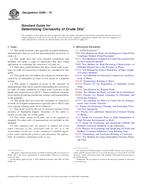
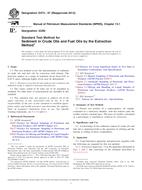 ASTM D473-07(2012)..
ASTM D473-07(2012)..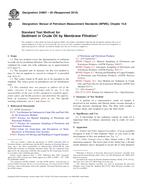 ASTM D4807-05(2010)..
ASTM D4807-05(2010)..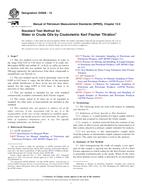 ASTM D4928-12
ASTM D4928-12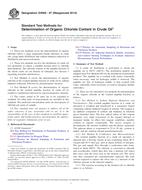 ASTM D4929-07(2014)..
ASTM D4929-07(2014)..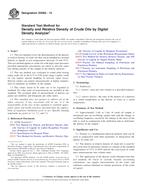 ASTM D5002-13
ASTM D5002-13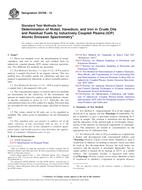 ASTM D5708-12
ASTM D5708-12
 Cookies
Cookies
